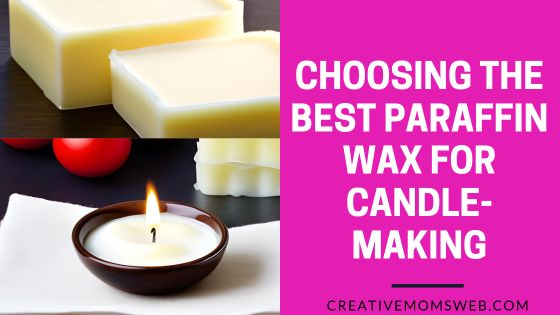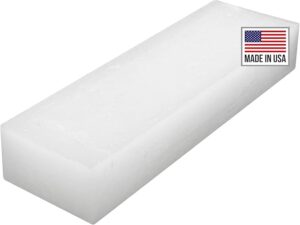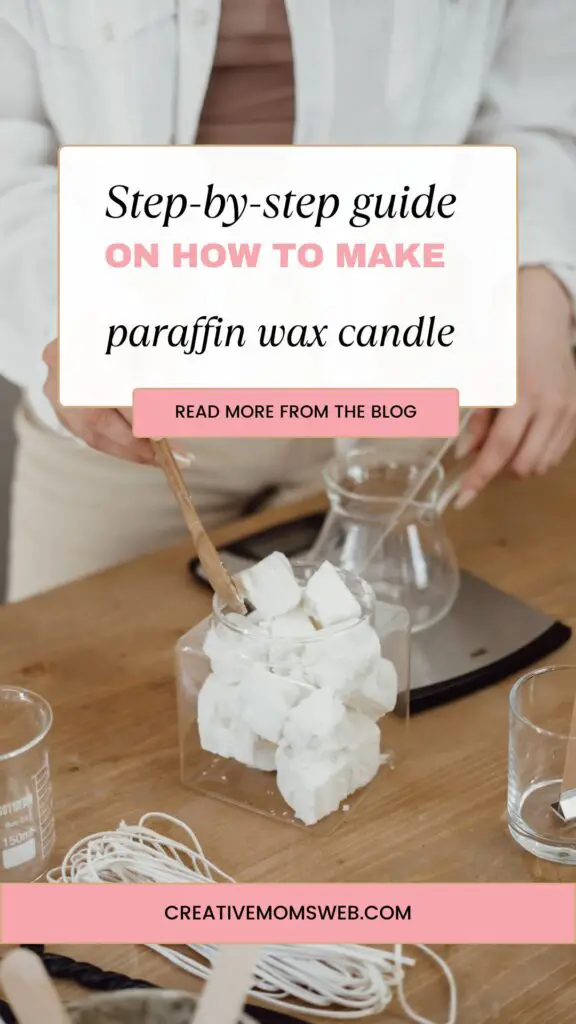Paraffin wax is a popular and widely used wax for candle making. It is derived from petroleum and is known for its affordability, versatility, and ability to hold fragrance well. Despite being a by-product of crude oil, paraffin wax has been used for candle making for many years and continues to be a preferred choice for many candle makers. However, there are also concerns about the environmental impact of paraffin wax and its potential health risks. In this blog post, we will explore the pros and cons of using paraffin wax for candle-making and provide tips on how to make the most of this versatile wax while also being mindful of its impact on the environment and our health.

Factors to consider when choosing the best paraffin wax for candle-making
Here are some factors to consider when choosing the best paraffin wax for candle-making:
- Melting point: Paraffin wax has a range of melting points, typically between 120-160°F. Different paraffin wax types have different melting points, which can affect the scent throw, burn time, and appearance of the candle. Consider the ambient temperature and climate in your area when choosing a paraffin wax with the appropriate melting point for your candle-making needs.
- Scent throw: Paraffin wax has a natural ability to hold and release fragrance. However, some paraffin waxes may have a stronger scent throw than others. Look for a paraffin wax that has been specifically formulated for candle-making and has good scent throw performance.
- Appearance: Paraffin wax can have a range of appearances, from opaque to translucent. Some paraffin waxes may also have a glossy or mottled finish, which can affect the appearance of the candle. Consider the appearance you desire for your candles when choosing a paraffin wax.
- Additives: Some paraffin waxes may contain additives, such as stearic acid or vybar, which can affect the performance of the wax in candle-making. These additives can improve adhesion, opacity, and scent throw, but may also affect the natural properties of the wax.
- Safety: When using paraffin wax for candle-making, it’s important to follow safety guidelines and use caution. Paraffin wax is highly flammable and should be melted in a double boiler or wax melter. Never heat the wax directly over an open flame.
- Sustainability: While paraffin wax is a popular choice for candle-making, it is not an eco-friendly or sustainable option. Paraffin wax is derived from petroleum, which is a non-renewable resource. It also emits harmful chemicals, such as benzene and toluene, when burned.
Pros and cons of using paraffin wax for candle-making
Here are some pros and cons of using paraffin wax for candle making:
Pros:
- Affordability – Paraffin wax is relatively inexpensive, making it a popular choice for candle makers on a budget.
- Easy to use – Paraffin wax is easy to work with and can be melted and poured easily.
- Versatility – Paraffin wax can be used to make a wide variety of candle types, from votives to pillars and container candles.
- Fragrance retention – Paraffin wax holds fragrance oils well and can produce strong, long-lasting scents.
- Smooth finish – Paraffin wax has a smooth, glossy finish that is visually appealing.
Cons:
- Environmental concerns – Paraffin wax is derived from petroleum, which is a non-renewable resource. The production and use of paraffin wax also contribute to carbon emissions and can be harmful to the environment.
- Health risks – Burning paraffin wax candles can release potentially harmful chemicals, such as benzene and toluene, which can cause respiratory issues.
- Flammability – Paraffin wax is highly flammable and can pose a fire hazard if not used properly.
- Limited natural appeal – Paraffin wax is a synthetic material and lacks a natural appeal and eco-friendliness of other waxes, such as soy or beeswax.
- Soot – Paraffin wax can produce more soot than other waxes, which can be messy and difficult to clean up.
Popular paraffin wax for candle-making

Overview: Blended Waxes, Inc. offers a versatile paraffin wax suitable for various candle-making projects. This wax is fully refined and designed for creating both container and pillar candles, making it a versatile option for different types of candles.
Pros:
- Versatility: This paraffin wax is suitable for making both container and pillar candles, providing flexibility in your candle-making projects.
- High Melting Point: The wax has a high melting point, ensuring that the candles hold their shape well and have a longer burn time.
- Good Scent Throw: It holds fragrance oils well, offering a good scent throw in finished candles.
- Smooth Finish: The wax produces a smooth and even finish, enhancing the appearance of your candles.
Cons:
- Melting Time: Due to its high melting point, the wax may take longer to melt compared to other paraffin waxes.
- Price: This wax is slightly more expensive than some other options, but the quality justifies the cost.
User Reviews: Users appreciate the versatility and high quality of Blended Waxes, Inc. Paraffin Wax. Many highlight its ability to produce both container and pillar candles with a smooth finish and good scent throw. The longer burn time is also noted as a significant advantage.
Final Verdict: Blended Waxes, Inc. Paraffin Wax is an excellent choice for candle makers looking for a versatile and high-quality paraffin wax. Its suitability for both container and pillar candles, along with its good scent throw and smooth finish, make it a valuable addition to any candle maker’s supplies.
Step-by-step guide on how to make paraffin wax candle
Making a paraffin wax candle is a simple process that can be done at home with a few basic materials and tools. Here are the steps to make a paraffin wax candle:
Materials:
- Paraffin wax
- Candlewick
- Candle dye (optional)
- Candle fragrance oil (optional)
Tools:
- Double boiler or a pot and a heat-proof container
- Candy thermometer
- Stirring spoon
- Scissors
- Clothespins or a wick-centering tool
- Candle molds or jars
Instructions:
- Melt the paraffin wax in a double boiler or in a heat-proof container placed in a pot of simmering water. Use a candy thermometer to monitor the temperature and ensure that it does not exceed 180°F (82°C).
- While the wax is melting, prepare the candle molds or jars by attaching the wick to the center of the mold or jar using a clothespin or wick-centering tool.
- If you want to add color or fragrance to your candle, mix candle dye or fragrance oil with the melted wax according to the manufacturer’s instructions.
- Pour the melted wax into the prepared molds or jars, leaving about 1/2 inch of space at the top. Be careful not to pour the wax too quickly as it may cause air bubbles to form.
- Allow the candles to cool and solidify for several hours or overnight.
- Once the candles have hardened, trim the wick to about 1/4 inch above the wax surface, and enjoy your handmade paraffin wax candle!
Tips for Using Paraffin Wax for Candle-Making
When using paraffin wax for candle making, there are a few tips that you can follow to get the best results:
- Use a double boiler: When melting paraffin wax, it is important to use a double boiler to prevent the wax from overheating.
- Add fragrance oil and dye: Paraffin wax is a good choice for candles that require fragrance oil or dye. Simply add the desired amount of fragrance oil or dye to the melted wax and stir until it is evenly distributed.
- Trim the wicks: Once the candles have cooled, it is important to trim the wicks to about 1/4 inch above the surface of the wax. This will help prevent the wicks from smoking or getting too long.
- Store the candles in a cool, dry place: Paraffin wax candles should be stored in a cool, dry place to prevent them from melting or becoming discolored.
In conclusion, paraffin wax is a versatile and widely-used material for making candles. It is readily available, relatively inexpensive, and easy to work with, making it a popular choice for both novice and experienced candle makers alike.
While paraffin wax has some drawbacks, such as its non-renewable source and potential health risks when burned, it remains a popular choice due to its reliable performance and ability to produce a wide range of candle shapes and sizes.
Whether you are making candles for personal use or to sell, paraffin wax can provide a great starting point for your candle-making journey. With proper safety precautions and attention to detail, you can create beautiful and long-lasting candles that are sure to delight your senses and bring warmth and ambiance to any space.

Shop My Favorite Essentials for Candle Making: A Complete Guide for Stay-at-Home Moms
Candle making is a fantastic hobby that allows stay-at-home moms to tap into their creativity, relax, and even start a small business. Whether you’re a beginner or looking to refine your skills, having the right tools and materials is essential. Here’s a list of must-have candle making supplies available on Amazon to get you started. Each item includes a specific product example to make your shopping easier.
1. Wax
Wax is the foundation of any candle. Different types of waxes like soy, beeswax, and paraffin have their unique benefits.
Recommended Product:
- NatureWax C-3 Soy Wax
NatureWax C-3 Soy Wax on Amazon
This all-natural soy wax is perfect for beginners. It provides a smooth finish and excellent scent throw, ideal for container candles.
- Paraffin wax
Blended Waxes, Inc. offers a versatile paraffin wax suitable for various candle-making projects. This wax is fully refined and designed for creating both container and pillar candles, making it a versatile option for different types of candles.
- Palm wa
This palm wax can be used to make many types of candles, including pillars, votives, tapers, and tealights. It can be heated to 180 °F (82 °C). You may choose any fragrance for your candle or leave it unscented.
- Coconut wax
The True Coconut Premium All-Natural Coconut Wax Blend is a game-changer for DIY candle makers seeking a luxurious and eco-friendly option. This wax burns exceptionally clean, delivering an impressive fragrance throw that fills the room without any unpleasant residue. Its soft texture ensures excellent adhesion to glass jars, making it easy to create professional-looking candles.
2. Wicks
Choosing the right wick is crucial for an even burn. Cotton wicks are the most popular, but wood wicks can add a unique crackling sound.
Recommended Product:
- EricX Light 100 Piece Cotton Candle Wicks
EricX Light Candle Wicks on Amazon
These eco-friendly cotton wicks are pre-waxed and come in various sizes, making them perfect for different candle types.
3. Fragrance Oils
To add delightful scents to your candles, fragrance oils are a must. Make sure they are specifically formulated for candle making.
Recommended Product:
- P&J Trading Fragrance Oil Set
P&J Trading Fragrance Oil Set
This set includes a variety of scents like lavender, vanilla, and sandalwood. The oils are highly concentrated, ensuring a long-lasting fragrance.
4. Dye for Candle Coloring
If you want to add color to your candles, go for candle-specific dyes that won’t clog your wick.
Recommended Product:
- Candle Shop Candle Dye Flakes
Candle Dye Flakes
These dye flakes come in a variety of colors and are easy to use. Just a small amount can give you vibrant colors without affecting the candle’s performance.
5. Candle Molds
For creative shapes beyond standard jars, silicone molds are a versatile option.
Recommended Product:
- Cozyours Silicone Candle Molds
Cozyours Silicone Molds
These reusable molds come in various shapes like hearts and stars, perfect for making unique candles.
6. Candle Pouring Pot
A pouring pot is essential for safely melting and pouring your wax. It allows for easy control to prevent spills.
Recommended Product:
- CandleScience Aluminum Pouring Pot
CandleScience Pouring Pot
With a 2-pound capacity, this pouring pot is lightweight, durable, and perfect for handling hot wax.
7. Thermometer
Temperature is key in candle making. A thermometer ensures your wax is at the optimal temperature for adding fragrance and pouring.
Recommended Product:
- KT THERMO Deep Fry Thermometer with Clip
KT THERMO Deep Fry Thermometer
This stainless steel thermometer comes with a clip, making it easy to attach to your melting pot. It provides accurate readings between 50°F and 550°F, perfect for monitoring wax temperature. The large dial display ensures you can easily read the temperature, and the clip keeps it secure during the melting process.
Key Features:
- Temperature Range: 50°F to 550°F (10°C to 290°C)
- Clip Attachment: Securely clips onto the side of your pot for hands-free monitoring
- Large, Easy-to-Read Dial: Clear display for quick temperature checks
- Durable Stainless Steel Construction: Built to last and easy to clean
This thermometer is versatile and can also be used for cooking, making it a handy tool to have in your kitchen.
8. Heat Gun
A heat gun helps smooth out the tops of candles and fix imperfections like sinkholes.
Recommended Product:
- Chandler Tool Heat Gun
Chandler Tool Heat Gun
This compact heat gun is perfect for candle makers. It features two heat settings and a built-in stand.
9. Candle Labels
For a professional finish, especially if you’re selling your candles, consider using pre-made labels or printable sticker sheets.
Recommended Product:
- Avery Printable Round Labels
Avery Round Labels
These glossy labels are easy to customize and print, giving your candles a professional touch.
10. Candle Containers
Containers like tins, jars, and votives are essential for making container candles.
Recommended Product:
- Accguan 12 Pack Glass Candle Jars with Bamboo Lids
Accguan Glass Candle Jars
These elegant glass jars come with airtight bamboo lids, perfect for preserving the scent of your candles. They have a modern and minimalist design, making them ideal for creating gifts or selling candles. Each jar holds about 7 oz, which is perfect for medium-sized candles.
Key Features:
- Quantity: 12 jars per pack
- Capacity: 7 oz per jar
- Material: High-quality, heat-resistant glass with bamboo lids
- Design: Clear glass for a sleek look, ideal for showcasing candle colors
- Versatile Use: Great for candle making, storage, or home decor
- YIHANG 24 Pack Candle Tins
YIHANG Candle Tins
These tins come with lids and are perfect for travel candles or gift sets. They are durable and reusable.
11. Wick Centering Device
To ensure your wick stays perfectly centered as your candle sets, a centering device is a handy tool.
Recommended Product:
- DINGPAI Adjustable Candle Wick Holders (12-Pack)
DINGPAI Adjustable Wick Holders
These adjustable wick holders are designed to fit various container sizes, making them a versatile choice for candle making. Made from durable stainless steel, they can be adjusted to perfectly center your wick in jars, tins, and other containers. The adjustable arms allow you to secure multiple wick types, whether you’re using cotton or wooden wicks.
Key Features:
- Quantity: 12 holders per pack
- Material: High-quality stainless steel, built to last
- Adjustable Design: Expandable arms to fit containers from 2 inches to 4 inches wide
- Versatility: Suitable for single or double wicks, as well as wood wicks
- Ease of Use: Keeps wicks perfectly centered for an even burn
12. Safety Equipment
Safety should always come first. Protect yourself with gloves, aprons, and safety glasses when working with hot wax.
Recommended Product:
- NoCry Cut Resistant Gloves
NoCry Gloves
These gloves are heat-resistant and protect your hands from hot wax spills and burns.
